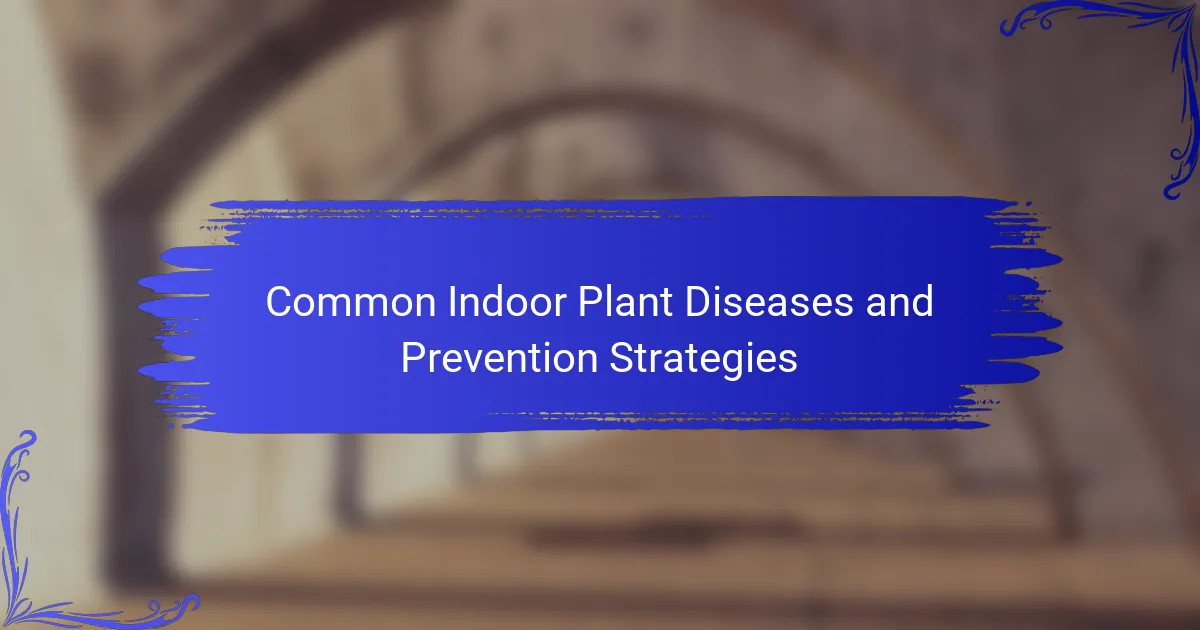Common indoor plant diseases include root rot, powdery mildew, and leaf spot, each posing significant threats to plant health. Root rot is primarily caused by overwatering, resulting in fungal infections that decay the roots. Powdery mildew appears as white spots on leaves and thrives in high humidity with poor air circulation. Leaf spot disease manifests as dark spots on foliage, typically caused by bacterial or fungal pathogens. Effective prevention strategies involve maintaining proper humidity, ensuring good air circulation, and implementing appropriate watering techniques, which can significantly reduce the risk of these diseases and promote healthier indoor plants.

What are Common Indoor Plant Diseases?
Common indoor plant diseases include root rot, powdery mildew, and leaf spot. Root rot occurs due to overwatering, leading to fungal infections. Powdery mildew presents as white powdery spots on leaves, often caused by high humidity and poor air circulation. Leaf spot disease manifests as dark spots on leaves, typically from bacterial or fungal pathogens. These diseases can weaken plants, hinder growth, and lead to plant death if untreated. Proper care, including appropriate watering and air circulation, can prevent these diseases.
How do indoor plant diseases affect plant health?
Indoor plant diseases negatively impact plant health by causing various symptoms such as wilting, yellowing leaves, and stunted growth. These diseases arise from pathogens like fungi, bacteria, and viruses that invade the plant. Infected plants may experience reduced photosynthesis due to leaf damage. This leads to lower energy production, further weakening the plant. Additionally, diseases can spread to other plants, exacerbating the problem. The overall vitality and aesthetic appeal of indoor plants can diminish significantly due to these diseases. Proper identification and management are essential to mitigate these effects and maintain plant health.
What are the common symptoms of indoor plant diseases?
Common symptoms of indoor plant diseases include yellowing leaves, wilting, and stunted growth. Yellowing leaves often indicate nutrient deficiencies or root problems. Wilting can result from overwatering or underwatering. Stunted growth may be a sign of pest infestations or disease. Additionally, spots or lesions on leaves suggest fungal or bacterial infections. Mold or mildew on the soil surface indicates excess moisture. Finally, leaf drop can occur due to environmental stress or disease. These symptoms help identify underlying issues affecting indoor plants.
How can I identify specific indoor plant diseases?
To identify specific indoor plant diseases, examine the plant for visible symptoms. Common indicators include yellowing leaves, wilting, or unusual spots. Fungal infections often present as mold or mildew on leaves. Bacterial diseases may cause water-soaked spots or leaf drop. Pests, like spider mites or aphids, can also lead to damage. Check the soil for signs of rot or pests. Accurate identification often requires comparing symptoms with resources like plant disease guides. Field studies show that timely diagnosis improves treatment success rates.
Why is prevention important for indoor plant diseases?
Prevention is crucial for indoor plant diseases to maintain plant health and vitality. Healthy plants are less susceptible to diseases, which can lead to significant damage and loss. Preventative measures, such as proper watering, adequate light, and regular inspections, help identify issues early. Early detection can prevent the spread of diseases to other plants. According to research, up to 80% of plant diseases can be prevented through good cultural practices. Implementing these strategies reduces the need for chemical treatments, promoting a healthier environment.
What are the consequences of ignoring indoor plant diseases?
Ignoring indoor plant diseases leads to plant decline and potential death. Affected plants may exhibit stunted growth, yellowing leaves, and wilting. These symptoms indicate that the plant is struggling to thrive. Furthermore, untreated diseases can spread to other nearby plants. This results in a larger infestation and increased difficulty in management. Economic loss can occur due to the need for replacements or treatments. Additionally, some diseases may pose health risks to humans and pets. For instance, mold can trigger allergies and respiratory issues. Overall, neglecting indoor plant diseases can significantly impact both plant health and indoor environments.
How does proper care contribute to disease prevention?
Proper care significantly contributes to disease prevention in indoor plants. Healthy plants are more resilient to pathogens and pests. Regular watering, appropriate light, and proper nutrition enhance plant vigor. This vigor helps plants withstand environmental stress and disease challenges. For instance, overwatering can lead to root rot, while insufficient light weakens plants. Additionally, maintaining cleanliness by removing dead leaves prevents fungal growth. Research shows that well-cared-for plants exhibit fewer disease symptoms. This correlation underscores the importance of proper care in promoting plant health and preventing disease outbreaks.

What are the Most Common Types of Indoor Plant Diseases?
The most common types of indoor plant diseases include root rot, powdery mildew, and leaf spot. Root rot occurs due to overwatering and poor drainage, leading to plant decay. Powdery mildew is a fungal disease characterized by white powdery spots on leaves. Leaf spot diseases, caused by various fungi and bacteria, result in dark or discolored spots on foliage. These diseases can weaken plants and hinder growth. Proper care and monitoring can help prevent these issues.
What fungal diseases affect indoor plants?
Fungal diseases that affect indoor plants include powdery mildew, root rot, and leaf spot. Powdery mildew appears as white, powdery spots on leaves and thrives in high humidity. Root rot is caused by overwatering and leads to plant wilting and decay of roots. Leaf spot manifests as dark, water-soaked spots on leaves, often leading to leaf drop. These diseases can weaken plants and reduce their growth. Proper care, including adequate air circulation and appropriate watering, can help prevent these fungal issues.
How can I recognize and treat powdery mildew?
Powdery mildew is recognized by its white, powdery spots on leaves and stems. This fungal disease thrives in warm, dry conditions. Leaves may appear distorted or yellowed as the disease progresses. To treat powdery mildew, increase air circulation around plants. Water plants at the base to avoid wetting leaves. Fungicides can be applied as a treatment option. Organic solutions include a mixture of baking soda and water. Regularly inspect plants for early signs to prevent spread. Timely intervention is crucial for effective management of powdery mildew.
What are the signs of root rot in indoor plants?
Signs of root rot in indoor plants include yellowing leaves and wilting stems. Affected plants may have a mushy or darkened root system. The soil often appears overly wet and may emit a foul odor. In severe cases, the plant may stop growing entirely. These symptoms indicate that the roots are not functioning properly due to excess moisture and decay. Root rot is commonly caused by overwatering or poor drainage. Identifying these signs early can help prevent further damage and save the plant.
What bacterial diseases should I be aware of?
Common bacterial diseases to be aware of include bacterial blight, bacterial wilt, and crown gall. Bacterial blight affects leaves and stems, causing water-soaked spots and yellowing. Bacterial wilt leads to wilting and yellowing of plants, often resulting in plant death. Crown gall causes tumor-like growths on roots and stems, impacting plant health. These diseases are caused by specific bacteria, including Xanthomonas and Agrobacterium species. Identifying these diseases early is crucial for effective management and prevention. Proper sanitation and resistant plant varieties can help mitigate their impact.
How does bacterial leaf spot manifest in indoor plants?
Bacterial leaf spot manifests in indoor plants as water-soaked lesions on leaves. These lesions can progress to dark brown or black spots with yellow halos. The spots may be irregularly shaped and can merge, leading to larger areas of necrosis. Affected leaves may curl or drop prematurely. This disease is often exacerbated by high humidity and poor air circulation. Bacterial leaf spot is caused by various bacterial pathogens, including Xanthomonas and Pseudomonas species. Proper sanitation and avoiding overhead watering can help prevent its spread.
What treatment options are available for bacterial diseases?
Antibiotics are the primary treatment options available for bacterial diseases. These medications target and kill bacteria or inhibit their growth. Common antibiotics include penicillin, tetracycline, and amoxicillin. Treatment choice depends on the specific bacterial infection. For instance, penicillin is effective against streptococcal infections. Tetracycline is often used for respiratory infections. Amoxicillin is frequently prescribed for ear infections. In some cases, supportive care may be necessary alongside antibiotics. This can include hydration and pain management. Proper diagnosis by a healthcare professional is crucial for effective treatment.
What viral diseases can impact indoor plants?
Viral diseases that can impact indoor plants include Tobacco Mosaic Virus (TMV), Cucumber Mosaic Virus (CMV), and Tomato Spotted Wilt Virus (TSWV). TMV causes mottling and discoloration on leaves, affecting plants like peppers and tomatoes. CMV leads to yellowing and stunted growth, commonly affecting cucumbers and melons. TSWV causes wilting and necrosis, primarily impacting tomatoes and ornamentals. These viruses can spread through contaminated tools, insects, or plant-to-plant contact. Identifying symptoms early can help in managing these diseases effectively.
How can I identify viral infections in my plants?
Viral infections in plants can be identified by specific symptoms. Look for unusual leaf discoloration, such as yellowing or mottling. Stunted growth and distorted leaves are also common indicators. Additionally, you may observe abnormal flower patterns or reduced fruit production. These symptoms often signal a viral presence. Testing can confirm the diagnosis, such as using enzyme-linked immunosorbent assay (ELISA) or polymerase chain reaction (PCR) methods. Regular monitoring and prompt action are essential for managing viral infections effectively.
What are the best practices for managing viral diseases?
Best practices for managing viral diseases include maintaining plant health, isolating infected plants, and using resistant varieties. Healthy plants are less susceptible to viral infections. Regularly check plants for signs of viral symptoms, such as mottled leaves or stunted growth. If symptoms are detected, immediately isolate the infected plant to prevent the spread of the virus. Proper sanitation practices, such as disinfecting tools and pots, can reduce the risk of transmission. Additionally, using virus-resistant plant varieties can significantly lower the incidence of viral diseases. Research indicates that these practices can effectively manage and reduce the impact of viral diseases in indoor plants.

What are Effective Prevention Strategies for Indoor Plant Diseases?
Effective prevention strategies for indoor plant diseases include maintaining proper humidity levels and ensuring adequate air circulation. High humidity can promote fungal growth, while good air circulation helps prevent disease spread. Regularly inspecting plants for signs of disease allows for early intervention. Quarantining new plants for a few weeks can prevent the introduction of pests and diseases. Using sterile soil and clean pots reduces the risk of soil-borne pathogens. Proper watering techniques are crucial; overwatering can lead to root rot. Additionally, providing appropriate light conditions helps keep plants healthy and resilient against diseases. Following these strategies can significantly reduce the incidence of indoor plant diseases.
How can I create a healthy environment for my indoor plants?
To create a healthy environment for indoor plants, ensure they receive adequate light. Most indoor plants thrive in bright, indirect sunlight. Monitor humidity levels, as many plants prefer a humidity range of 40-60%. Water plants according to their specific needs, avoiding overwatering which can lead to root rot. Use well-draining soil to promote healthy root growth. Regularly check for pests, as infestations can harm plants. Fertilize during the growing season to provide essential nutrients. Rotate plants occasionally to ensure even light exposure. These practices support plant health and reduce the risk of diseases.
What role does light and humidity play in disease prevention?
Light and humidity significantly influence disease prevention in indoor plants. Adequate light enhances photosynthesis, boosting plant health and resilience. Healthy plants are less susceptible to diseases. Conversely, insufficient light can weaken plants, making them more vulnerable to pathogens.
Humidity affects the moisture levels in the air surrounding plants. High humidity can promote fungal growth, leading to diseases like powdery mildew. Conversely, low humidity can cause stress, making plants more prone to infestations.
Maintaining optimal light and humidity levels creates an environment that supports plant health. Research indicates that specific light conditions can reduce the incidence of diseases in plants. For example, studies show that UV light can inhibit certain fungal pathogens.
How often should I inspect my plants for signs of disease?
Inspect your plants for signs of disease at least once a week. Regular inspections help identify issues early. Early detection can prevent the spread of diseases. Many common plant diseases develop quickly. Weekly checks allow for timely intervention. Research indicates that frequent monitoring significantly improves plant health outcomes. Consistent observation can lead to healthier plants overall.
What cultural practices can help prevent indoor plant diseases?
Cultural practices that can help prevent indoor plant diseases include proper watering, adequate light, and regular cleaning. Overwatering can lead to root rot, so it’s essential to water plants based on their specific needs. Ensuring plants receive the right amount of light prevents stress and susceptibility to diseases.
Regularly cleaning plant leaves removes dust and pests that can harbor diseases. Additionally, rotating plants helps them grow evenly and reduces the likelihood of disease spread. Using sterilized tools when pruning or repotting minimizes the risk of introducing pathogens.
Maintaining proper humidity levels can also prevent fungal infections. Lastly, ensuring good air circulation around plants discourages the growth of mold and mildew. These practices collectively create a healthier environment for indoor plants.
How does proper watering contribute to plant health?
Proper watering is essential for plant health as it ensures adequate nutrient uptake. Water facilitates the movement of nutrients from the soil into the plant. It also helps maintain cell turgor, which is crucial for structural integrity. Insufficient watering can lead to wilting and stress, making plants more susceptible to diseases. Overwatering can cause root rot, limiting oxygen access to roots. Healthy plants are better equipped to resist pests and diseases. Studies show that consistent watering practices improve overall plant vitality. For instance, research indicates that plants with optimal moisture levels exhibit enhanced growth rates and resilience.
What are the benefits of using sterilized soil and pots?
Using sterilized soil and pots prevents the introduction of pathogens. This practice minimizes the risk of diseases in indoor plants. Sterilization kills harmful bacteria, fungi, and pests. It also reduces competition from weeds. Healthy soil promotes better root development. Plants are more likely to thrive in disease-free environments. Research shows that sterilized soil can lead to higher plant yields. Overall, using sterilized materials enhances plant health and longevity.
What are some common troubleshooting tips for indoor plant diseases?
Inspect plants regularly for signs of disease, such as discoloration or wilting. Remove any affected leaves or stems immediately to prevent the spread of infection. Ensure proper watering practices; overwatering can lead to root rot. Adjust light exposure according to the plant’s needs; insufficient light can weaken plants. Maintain humidity levels appropriate for the specific plant species. Use organic fungicides or insecticides as needed to treat infestations. Quarantine new plants for a few weeks before introducing them to existing collections. Clean pots and tools regularly to avoid cross-contamination.
How can I effectively manage an outbreak of plant disease?
To effectively manage an outbreak of plant disease, first identify the specific disease affecting the plants. Accurate identification allows for targeted treatment. Next, remove and dispose of infected plant material to prevent further spread. Quarantine affected plants to limit exposure to healthy ones. Implement appropriate treatments, such as fungicides or insecticides, based on the identified disease. Regularly monitor the plants for signs of disease recurrence. Additionally, improve overall plant health by providing optimal growing conditions, including proper watering and light. Research indicates that maintaining strong plants can reduce susceptibility to diseases.
What steps should I take if my plant shows signs of disease?
Identify the disease affecting your plant. Examine leaves, stems, and soil for symptoms. Remove any infected parts immediately to prevent spread. Isolate the affected plant from others. Adjust care practices, such as watering and light exposure. Treat the plant with appropriate fungicides or pesticides. Monitor the plant regularly for improvement or further issues. Ensure proper sanitation of tools and pots to avoid future diseases.
Common indoor plant diseases include root rot, powdery mildew, and leaf spot, which can significantly impact plant health and vitality. These diseases arise from various pathogens, leading to symptoms such as yellowing leaves, wilting, and stunted growth. Effective prevention strategies involve maintaining proper care, including adequate watering, light, and air circulation, as well as regular inspections for early detection. Understanding the signs and treatment options for these diseases is crucial for maintaining healthy indoor plants and preventing economic loss or health risks associated with untreated infections.
